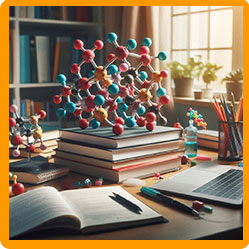
Structure & Bonding
Understanding how atoms join together and the structures they form is key to explaining the properties of materials. This topic covers different types of bonding, how substances are built, and how this affects their physical and chemical behaviour.
Ions and the Formation of Ions
Ions are charged particles formed when atoms gain or lose electrons to achieve a full outer shell, usually with 8 electrons.
- Metal atoms (on the left of the periodic table) lose electrons to form positive ions (cations).
- Non-metal atoms (on the right of the periodic table) gain electrons to form negative ions (anions).
The group number on the periodic table tells you how many electrons are in the outer shell and how many are gained or lost during ion formation.
Ionic Bonding and Ionic Compounds
Ionic bonding occurs between metals and non-metals. The metal loses electrons to become a positive ion, and the non-metal gains electrons to become a negative ion. The oppositely charged ions are held together by strong electrostatic forces.
You can represent this using dot and cross diagrams to show the transfer of electrons from one atom to another.
How Ionic Compounds Are Formed
For example, sodium (Na) loses one electron to form Na⁺, while chlorine (Cl) gains one electron to form Cl⁻. They combine to form sodium chloride (NaCl).
Giant Ionic Lattice
Ionic compounds form a giant lattice structure — a regular, repeating arrangement of ions held together by strong ionic bonds in all directions. This gives them:
- High melting and boiling points
- The ability to conduct electricity when melted or dissolved (because ions are free to move)
Covalent Bonding and Molecular Substances
Covalent bonds form when non-metal atoms share pairs of electrons to achieve a full outer shell. These shared electrons hold the atoms together.
Simple Molecular Substances
These consist of small molecules like H₂O, CO₂, or O₂. They:
- Have low melting and boiling points (due to weak forces between molecules)
- Don’t conduct electricity (no free electrons or ions)
Polymers
Polymers are long chains of covalently bonded molecules, made from repeating units called monomers. They have:
Strong covalent bonds in the chains
Weak intermolecular forces between chains
Higher melting points than simple molecules but lower than giant covalent structures
Revision Notes

The Cornell method is like a supercharged note-taking system that helps you ace your revision!
Print out our blank revision notes pages to help you revise.
How to make effective revision notes with the Cornell method.
Exam Questions & Answers

Download and print off practice our FREE worksheet with exam style questions on Cell Biology.
Giant Covalent Structures (Macromolecules)
Some substances form giant covalent structures, where all atoms are bonded by strong covalent bonds throughout the structure. These include:
Very high melting and boiling points
Usually don’t conduct electricity (except graphite)
Very hard or strong materials
Allotropes of Carbon
Carbon can form several different structures (called allotropes) because each carbon atom can make four bonds.
Diamond
- Each carbon bonded to 4 others
- Hardest natural substance
- Doesn’t conduct electricity
Graphite
- Each carbon is bonded to 3 others in layers
- Layers slide easily — used as a lubricant
- Conducts electricity due to free electrons
Graphene
- A single layer of graphite
- Strong and light
- Conducts electricity well — used in electronics
Fullerenes
- Molecules of carbon arranged in spheres or tubes
- E.g., Buckminsterfullerene (C₆₀)
- Used in drug delivery, lubricants, and nanotechnology
Metallic Bonding
Metallic bonding occurs in metals. Atoms are arranged in layers of positive ions surrounded by a sea of delocalised electrons. These free-moving electrons allow metals to:
- Conduct heat and electricity
- Be malleable and ductile (layers slide)
- Have high melting and boiling points
The strength of metallic bonding explains why metals are strong and useful for structural materials.
States of Matter and Changing State
Substances can exist in three states: solid, liquid, or gas.
- Solids have fixed shapes and particles in regular patterns.
- Liquids flow and take the shape of their container.
- Gases expand to fill the space and move freely.
Changing from one state to another involves adding or removing energy:
- Melting (solid → liquid)
- Boiling (liquid → gas)
- Condensing (gas → liquid)
- Freezing (liquid → solid)
- Sublimation (solid → gas)
These changes are physical, not chemical — the substance stays the same.
Nanoparticles and Their Uses
Nanoparticles are extremely small particles (1–100 nanometres in size), containing only a few hundred atoms. They have a very large surface area to volume ratio, which gives them unique properties.
Uses of Nanoparticles:
- In sun creams and cosmetics (transparent and effective)
- As drug delivery systems (targeting specific cells)
- In electronics, antibacterial coatings, and catalysts
However, the use of nanoparticles raises concerns about their long-term health and environmental effects, as their small size may allow them to enter the body or environment in unknown ways.
Also see Polymers, The Periodic Table, Atomic Structure
Revision Notes

The Cornell method is like a supercharged note-taking system that helps you ace your revision!
Print out our blank revision notes pages to help you revise.
How to make effective revision notes with the Cornell method.
Why Do I Need to Know About Structure And Bonding?
In Everyday Life
- Understanding how materials like plastics, metals, and glass are made
- Making better choices about insulation, cookware, or cleaning products
- Knowing how medicines or cosmetics work at a molecular level
- Explaining why some substances melt, dissolve, or react differently
- Appreciating how water, air, and your body rely on chemical bonds
In Science & Chemistry Careers
- Designing new materials, like flexible electronics or strong polymers
- Understanding chemical reactions in detail
- Developing nanoparticles or smart materials with unique structures
- Investigating drug design, fuels, or advanced manufacturing
- Working in fields like engineering, environmental science, or biochemistry


